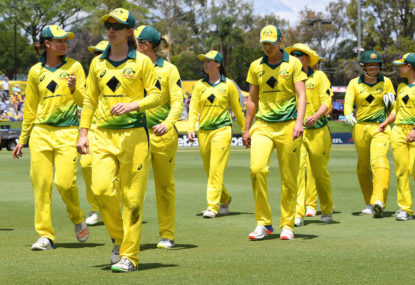World Cup chances up in the air but Smith makes Major call on T20 future, Green dumped despite huge IPL deal
Test great Steve Smith is to play for Washington Freedom in the second season of Major League Cricket as the Australian influence in the…

Australian women’s cricket coach Matthew Mott has publicly questioned whether England had any intention of playing for a win in the Test match given the slow run rate of the English first innings.
The question Mott raises is a valid one, but the motives of Mott and the Australians need to be questioned as well, given the Australian innings wasn’t played at a much faster run rate.
After winning the toss and electing to bat, England started the match slowly. Throughout the first session, the run rate of openers Tammy Beaumont and Lauren Winfield was barely one run per over before eventually creeping up towards two runs an over.
This is Test match cricket and nobody expects run-a-ball action, not even at North Sydney Oval. When you’re playing the first Test match in over two years, the tactical freshness isn’t going to be there and nerves will be flowing, so, of course, it will be slow going.
England finished day one at a slow 7/235 after the 100 over session – a 2.35 run rate. Despite claims the pitch was better to bat on in the night session, the runs never accelerated for England.
The first session of the second day saw England bat for 16 overs at almost three runs per over.
Out came the Aussies to bat, knowing the North Sydney Oval pitch was a road. It meant the Aussies could put a score on the English at a quick rate.
They didn’t.
At the best of times Aussie openers Nicole Bolton and Beth Mooney aren’t naturally attacking batters to start an innings and, just like the English openers, it was very slow and steady for Australia.
[latest_videos_strip category=”cricket” name=”Cricket”]
The problem for the Aussies – and likewise for Mott’s claims – was the Australian run rate couldn’t get past two runs per over for a majority of the innings.
It was the fifth wicket of Rachael Haynes that saw the Aussies lose a wicket with a run rate above two an over.
The first four batters to be dismissed for the Aussies had a strike rate of less than 35 – with Bolton topping them at 34.8.
The run rate picked up for the Aussies, but it was still very slow going.
Once the declaration came very late on the third day, Australia had batted 84 overs at two runs per over throughout day two. On day three they picked up the run rate, but still batted slowly through the innings.
The tactics from both sides looked ultra conservative and late into the middle session it was obvious the Aussies had succumbed to the draw.
Haynes wrapped her bowlers in cotton wool, with part-timers Nicole Bolton, Elyse Villani and even Haynes herself bowling in the middle session.
Throughout the match there were only four players to score at a strike rate over 50 – two English players (Heather Knight and Sarah Taylor) and two Australian players (Elyse Perry and Jess Jonassen for Australia).
If Australia was batting for the win then surely more players would’ve been close to or above the strike rate.
In the end, maybe England were playing for the draw to keep the Ashes series alive but, on the counter, the Australians never played for a win once they got the chance to bat, they kept the game at the slow rate for a draw.